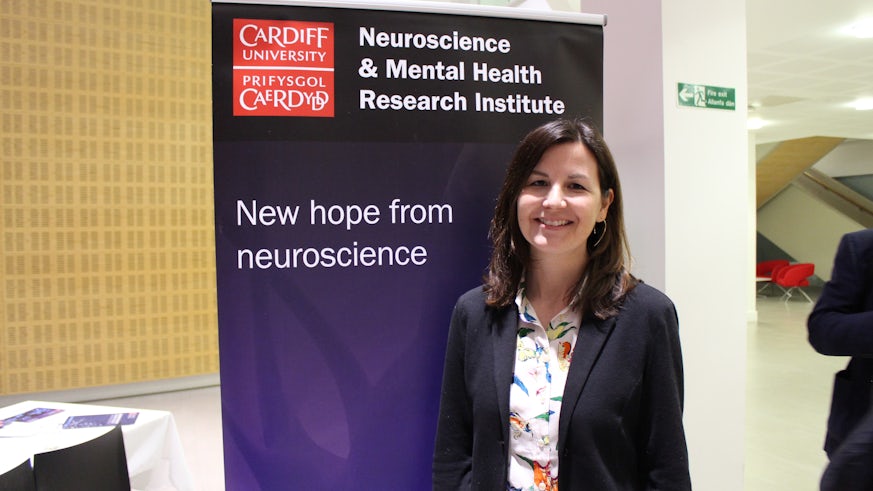Public lecture highlights the relationship between the immune system and brain development
19 Mawrth 2018

Dr Staci Bilbo, Director of Research at Harvard University's Lurie Center for Autism, delivered a talk on how microglia and other immune processes might hold the key to understanding brain development and potential causes for disorders like autism.
Introducing the talk, Dr Bilbo used the example of stress as a cause of disease, demonstrating the link between the brain and the immune system, and how psychological stresses impact its function.
Dr Bilbo went on to explain, “What’s less obvious is that the immune system is critical to how the brain works, for example being ill can impact on mood and cognition.
“Both systems are inextricably linked and dependent on each other to function and this has implications for the diseases we are developing cures for.
“None of us arrive at particular disease state or illness out of nowhere. Even disorders that affect us very late in life, like Alzheimer’s, have their origins very early on. So understanding how the immune system is impacted very early in life has implications on how organism functions and develops throughout life.”
Microglia
A focal point of the talk was microglia. Dr Bilbo explained how microglia don’t come from the same neural tissue as other cell types. Instead of proliferating from the neural tube, microglia come from the foetal yolk sac and invade the developing nervous system. By birth, microglia have spread throughout the entire central nervous system to become permanent residents. These are not only immune cells which play host defence roles in the brain; they are also critical for normal brain development.
“This is occurring during this time called Primitive Haematopoiesis. All the immune cells of the body come from foetal yolk sac early in development. All tissues in the body will receive their own resident populations of macrophages; the liver, kidney, gut and brain for example. However, the brain is unique because the blood-brain barrier then closes.
“We now know that there’s no continual replenishment from the periphery. The turnover of cells is very slow, in a human brain they live for about two decades. In the absence of trauma to the blood-brain barrier, you’re not getting any new ones. The ones you get early in life are for rest of your life. So it’s interesting to think about whether events that happen early in life impact the function of these cells long term.
Dr Bilbo remarked, “The big questions of my lab are determining what the long-term implications this has for neurological disorders.
“There is evidence in different fields that inflammation occurring during development through many different means can increase the risk of disorders such as autism, schizophrenia, cerebral palsy, cognitive disorders, mood disorders and many more.”
Environmental factors and autism spectrum disorder
The impact of air pollution and other environmental factors on cells and the way the brain develops are especially relevant today.
Dr Bilbo examined how these different factors contribute to the risk of autism.
She explained, “We know there’s a large genetic component but we know also that doesn’t account for all of it. There exists a large unexplained portion of risk resulting in disorder.
“Air pollution has increasingly been pointed to as one of the strongest epidemiological links to autism. People in the field are increasingly interested in the role of environmental factors and their link with inflammation. There exists an increasingly recognised immune abnormality in a significant subset of individuals with autism."
Air pollution is a pervasive problem around the world, with estimates that 92% of the world population live in areas that exceed safe air quality limits and pollution is now the third leading cause of mortality worldwide.
Dr Bilbo conducted a study mimicking air pollution with diesel exhaust particles (DEP) given to female mice throughout pregnancy. The results established links between prenatal DEP exposure and altered microglial colonisation and activation in the developing male brain.
“The cortical volume initially increased then decreased later in life in DEP exposed males only, similar to some observations in autism.”

Autism is a behaviourally defined disorder that has to show the core characteristics of social deficits, language impairment and repetitive behaviours in order to be diagnosed.
Dr Bilbo stated, “There are hundreds of genes and dozens of environmental factors implicated in autism; each alone only weakly predicts autism. One factor alone cannot explain it.
“Juvenile males exposed to DEP and maternal stressors showed social deficits, anxiety problems and cognitive deficits. The working hypothesis is that these two environmental hits potentially converge onto microglia to change the way the brain develops and underlie these behaviours.”
What now?
Early life events that impact the immune system can profoundly impact adult behaviour and physiology. The consequences of early life immune activation depend on an interaction with the later life environment as well.
In terms of attempting to intervene later, Dr Bilbo adds, “To answer this question we need to look beyond the brain. We know that brain disorders are often whole body disorders. This is especially true in autism. Many individuals present problems with digestion which contributes to behaviour. Looking at how changes in the gut, for example, might be changing behaviour and the potential for intervention.
“We know that microbiota in the gut is impacting the microglia in the brain - is this a window to what’s happening in the brain? Can we intervene?”
The talk was part of the Raymond and Beverly Sackler Foundation Distinguished Lecture in Neuroscience in honour of Professor Sir Keith Peters lecture series.
